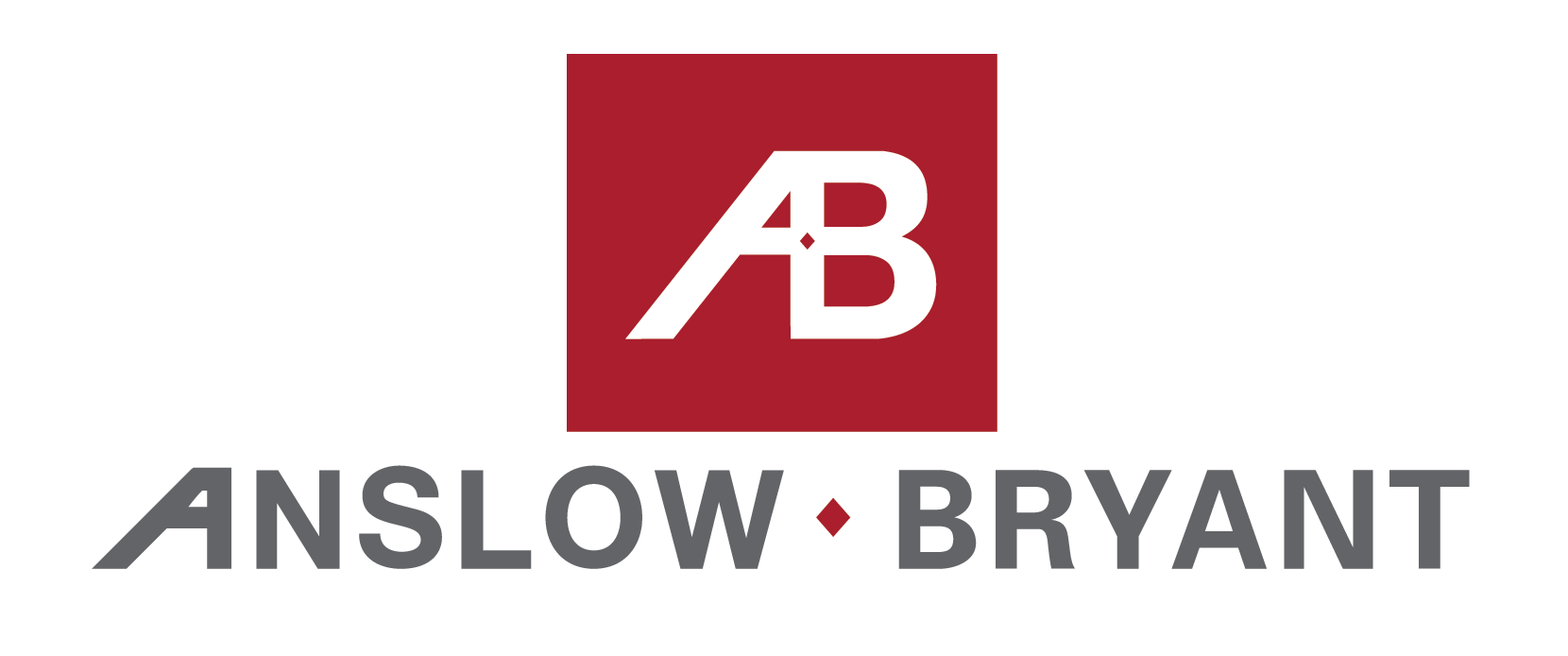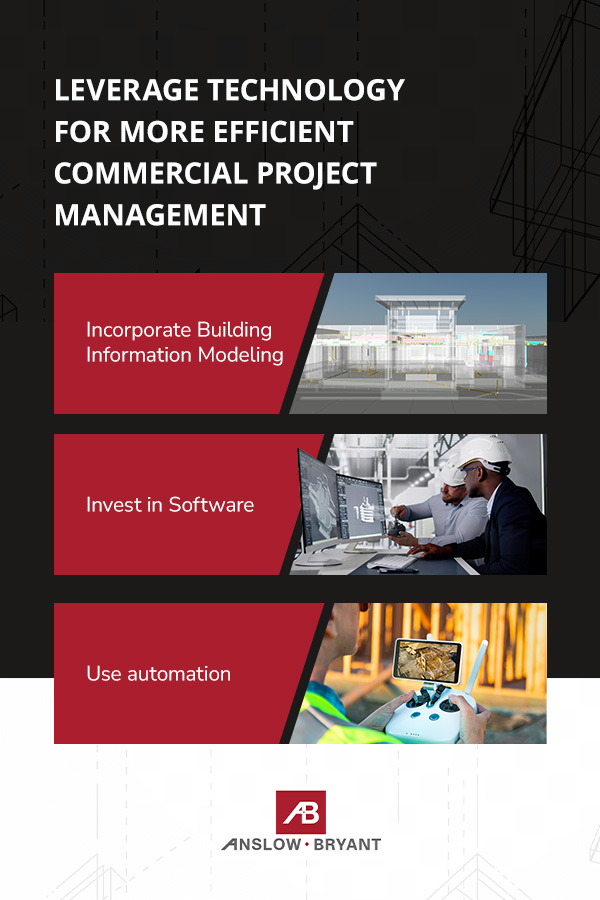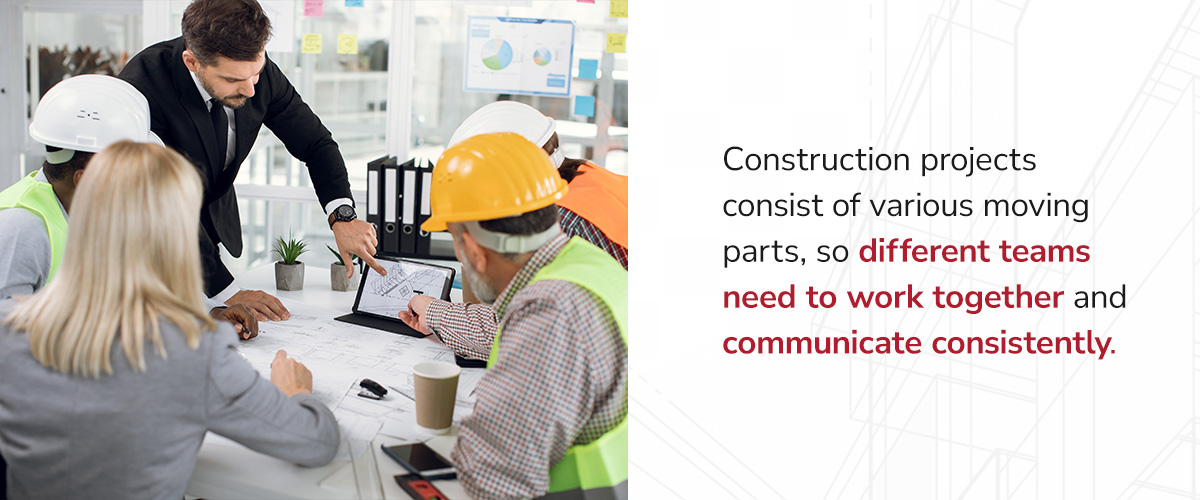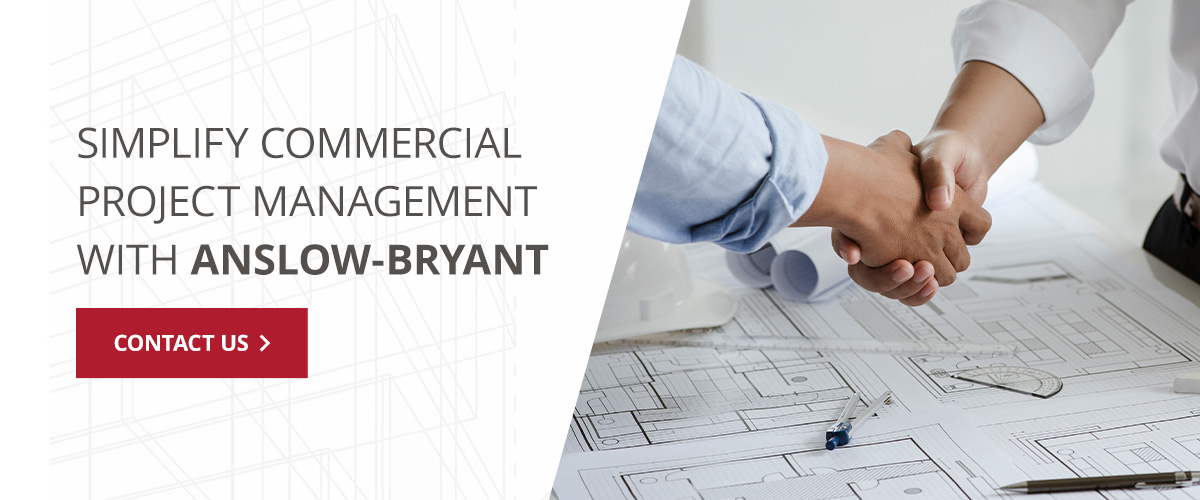8 Tips for Efficient Commercial Construction Project Management
Construction projects require careful planning, execution, quality control and progress monitoring, making a reliable project manager crucial. Project managers oversee every detail contributing to project success, including time, quality and cost. They keep tasks and activities on schedule, report to clients and stakeholders and ensure teams adhere to project specifications.
However, managing commercial construction projects can bring a host of challenges, including:
- Staying within the established budget.
- Ensuring the project meets rigorous quality control standards.
- Maintaining an effective communication system between contractors, subcontractors, stakeholders and other teams.
- Optimizing resources like materials, equipment and labor to prevent waste.
- Monitoring project progress and updating teams accordingly.
Use this advice to minimize these issues and ensure a successful project from start to finish.
8 Practical Construction Project Management Tips
From encouraging teamwork and communication to creating stringent quality control protocols, numerous strategies exist for effective commercial construction project management. Consider these eight tips.
1. Establish Clear Goals and Objectives
Defining tangible goals and objectives is the first step in executing a construction project. You can use the SMART goal framework as a guide.
Specific
Define the goal as clearly as possible. Consider these questions:
- What do you want the construction project to accomplish?
- What are the different tasks involved, and who is responsible for them?
- What steps should your team take to achieve the goal?
Perhaps your goal revolves around staying within the allotted budget, reducing project completion times, making the best use of available resources, reducing on-site incidents or improving communication across your team. Whatever the case, the goal should be precise.
Measurable
Establishing a quantifiable goal makes it easier to track progress with concrete metrics called key performance indicators. These might be percentages, dollar amounts or measurements of time. Here are some examples:
- Number of installation defects
- Time taken to address these flaws
- Incident rate
- Client satisfaction scores
- Budget variance
- Cash flow
- Percentage of labor downtime
Achievable
Your goal should be realistic and attainable. Can you and your team reasonably accomplish it? For instance, a six-month turnaround might be unrealistic if you’re working with a smaller construction crew and several complex tasks. Examine factors like your team, budget, available resources and time to build out a realistic goal.
Relevant
This step explores the “why?” and big-picture aspects of the goal. What short- and long-term benefits will the goal bring to your project, team, client and company? Think about how each objective contributes to the larger goals within your organization.
Time-Bound
Create your goal with a time frame and specific deadlines in mind. A shared schedule clarifies what everyone needs to accomplish and how much time they have to complete these tasks.
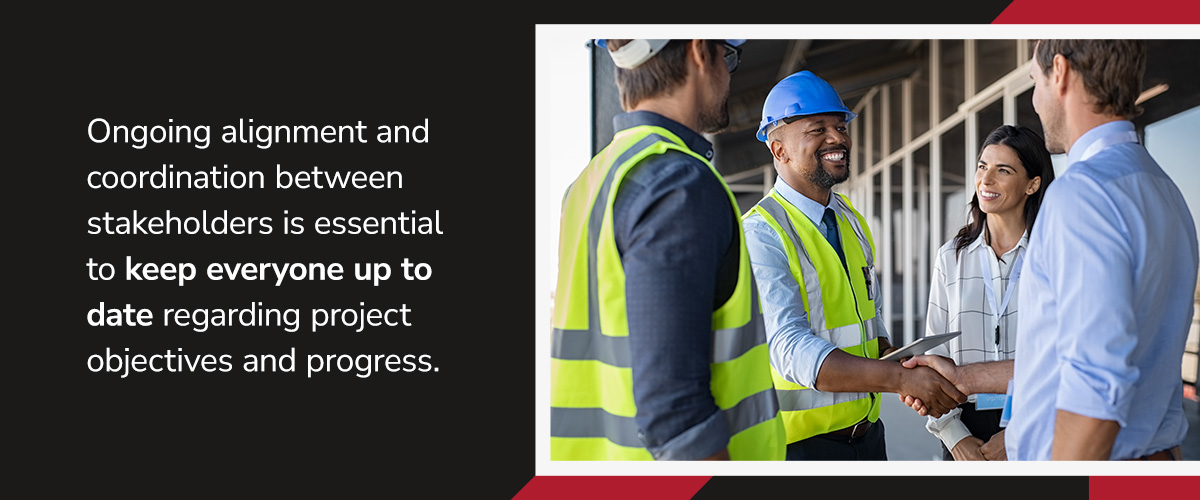
Ongoing alignment and coordination between stakeholders is essential to keep everyone up to date regarding project objectives and progress. Here are some examples of goals that combine the above five elements:
- Track and optimize the use of different building materials and reduce waste by 20%.
- Finish the building within one year from the project’s start date.
- Stay within a budget of $500,000 throughout the project.
- Achieve 100% accuracy in project documentation, including permits, construction drawings and change orders.
2. Develop a Comprehensive Project Plan
Once you’ve defined your project’s goals, scope and complexity, you can start creating a detailed plan for all stages of construction.
Thorough planning increases the likelihood of a successful project. The more detailed your plan is, the less likely unforeseen issues will emerge during the project. Everyone from project managers to construction crews to clients should understand this framework.
Start by breaking down the project into manageable tasks and milestones. You can also use project management tools and software to facilitate planning and scheduling. Here are some steps you can take to create a comprehensive project plan.
- Define the project: Determine the project’s purpose and objectives, including what you plan to build, how you’ll execute the project and who the relevant stakeholders are.
- Outline project activities: Define all necessary tasks and activities at each stage of construction, such as bricklaying, roofing, electrical work, plumbing and joinery.
- Develop a budget: Add all construction costs — including labor, equipment, materials and overhead expenses — to create a budget.
- Create a schedule: Once you understand the resources and activities needed for project completion, you can create a timeline to procure these resources and execute the tasks.
- Determine construction permissions: What are the necessary steps to receive project approval and ensure the building upholds municipal codes?
- Assemble a team: Select the project team and appoint contractors to execute different tasks. Decide who is leading and overseeing the project.
3. Allocate Resources Wisely
The efficient allocation of manpower, equipment and materials can help you prevent wasted resources, time and money. Regularly monitor and adjust your resource allocation strategy as needed.
Here are some strategies to optimize resource use and minimize waste.
- Order only what you need: You can avoid unnecessary misuse by having the correct sizes and quantities from the start. For instance, don’t order 12-foot drywall if you only need 10 feet. The same concept applies to construction equipment and human labor — only rent as much equipment and hire as many contractors as you need.
- Perform inventory checks: Regularly inspect your inventory to avoid renting or purchasing items you already have in stock.
- Reuse and recycle materials when possible: Many construction materials recycle, including brick, metal, asphalt, concrete and plastic. Have recycle bins on site to store these leftover materials rather than sending them to the landfill. You can even reuse some materials for future construction projects. Train your team to identify and sort recyclable and reusable materials.
- Partner with an expert: An experienced construction partner can work with you to reduce waste and maximize your available resources. The Anslow-Bryant Lean Method aims to eliminate various forms of waste: work waiting on workers, or workers waiting on work.
4. Foster Effective Communication
Communication is critical for success in any project. It facilitates teamwork and collaboration while reducing misunderstandings, delays and project issues down the road.
Establish communication channels among all project stakeholders to keep everyone in the loop. Here are some essential communication tips.
- Meet as a team: Hold regular progress meetings and updates to keep everyone on the same page. Weekly team meetings should cover project expectations, courses of action, progress updates and improvement areas, helping everyone understand their roles and responsibilities. Take notes of the primary points discussed during each meeting and share them with your team members so they can reference them when needed.
- Establish a chain of command: A communication chain eliminates confusion by ensuring everyone knows who to report to. The initial contract documents should outline this work site hierarchy. For instance, it might include the project owner, the project manager, general contractors, subcontractors and members of individual crews like electricians, plumbers, architects and engineers.
- Implement communication tools: Specialized tools and technology can streamline information sharing. For instance, cloud-based construction management software offers multiple features. You can view and share drawings, plans, specifications and other essential documents. You can also receive real-time updates about your project’s progress and action items.
5. Embrace Technology and Automation
High-tech tools are more critical than ever in the construction industry. They ensure more accurate site dimensions and measurements for construction teams. They also promote a more productive, efficient workflow by accelerating repetitive, mundane tasks.
Here are some ways to leverage technology for more efficient commercial project management.
- Incorporate Building Information Modeling: BIM helps enhance project visualization and coordination. It involves creating a digital rendering of a physical structure. The model provides detailed insights into the building’s materials, components and geometry, which you can easily reference for project decision-making applications. Stakeholders can also access these virtual representations and input feedback and requests.
- Invest in software: Besides facilitating communication, construction management software can streamline project tracking and documentation through real-time sharing and updates. You can view 3D models of your building and seamlessly transition to corresponding 2D drawings.
- Use automation: Implement automation tools for routine tasks to improve efficiency and accuracy. For example, drones with high-resolution cameras and advanced imaging technologies can facilitate site surveying and inspections. They can capture highly precise aerial images, providing detailed data for quality control, site analysis and project progress monitoring. Another example is autonomous self-driving machines, which can haul heavy materials across the work site. Invest in equipment like forklifts and trucks that can operate without human drivers due to robotic technologies and sensors.
6. Ensure Quality Control
Quality control ensures construction project deliverables meet standards dictated by the client and regulatory bodies, such as the Environmental Protection Agency and the Occupational Safety and Health Administration. An effective quality control plan involves:
- Implementing rigorous quality control measures to maintain construction standards.
- Conducting regular inspections and quality assurance checks.
- Addressing any issues promptly to prevent delays and cost overruns.
By implementing comprehensive quality control procedures, you can reduce the risk of costly errors, improve safety and yield better project results, thus increasing client satisfaction. Here are some steps to ensure quality control throughout your construction project.
- Establish and share acceptance criteria: Define quality standards so all crews, contractors and other team members fully understand client expectations and regulatory guidelines. Some standards for acceptance criteria might include zero visible defects, adherence to all manufacturer specifications and compliance with minimum building code standards.
- Develop an inspection plan: Regular inspections throughout the construction process are critical in a quality assurance plan. However, you should first establish what to inspect and what an acceptable outcome looks like. Your team should also know when inspections will occur and who will perform them. Third-party inspectors may be responsible for this task in some cases.
- Create a quality control checklist: A standardized checklist simplifies communication and managing quality control criteria across teams. It streamlines the inspection process, confirming nobody overlooks crucial aspects. A checklist can also convey team members’ specific responsibilities.
- Address deficiencies and inaccuracies: Continuously monitor teams and construction sites to pinpoint areas of concern. Resolve any shortcomings that arise. For example, say a crew member installs a #4 reinforcing steel bar when the specifications requested #5 reinforcing steel. To address this error, you might physically mark the problem area, report the issue and assign someone to correct it. Your team can proceed with the concrete pour once you’ve affirmed the correct bar placement.
7. Foster Collaboration and Teamwork
Construction projects consist of various moving parts, so different teams need to work together and communicate consistently. Here’s how to encourage collaboration across your entire team.
- Cultivating a collaborative environment: Besides gathering everyone for team meetings, you can promote collaboration beyond the work environment. Provide opportunities to build relationships through team-building activities or company-provided lunches or dinners. These activities can help different teams become better acquainted with one another.
- Encouraging open communication and problem-solving: Construction crews and contractors should bel comfortable reporting to project managers and upper management. Inviting team members to share feedback by distributing surveys or encouraging open-ended discussion during meetings helps them feel heard, valued and understood.
- Recognizing and rewarding teamwork and innovation: Rewards can incentivize team members to collaborate effectively. For instance, construction crews can work toward quarterly team goals to earn prizes like bonuses, gift cards or fun outings.
8. Monitor Progress and Adapt Accordingly
Continuously monitor project progress against milestones and objectives. Once you’ve established the schedule for your project and accounted for all tasks, determine how you’ll track their progress.
There are multiple tracking methods, such as digital tools and software, daily logs and physical inspections. The project’s size and complexity, available resources and budget can help you determine the ideal approach. Here are some other tips for monitoring project status.
- Be consistent: Track progress regularly through on-site inspections, daily or weekly reports or frequent updates through digital tools. These evaluations can help you adjust any project strategies as needed. Staying vigilant keeps the project on schedule and within budget (PPC-Planned Percent Complete).
- Identify potential issues and setbacks: Remain agile and adaptable to project scope, timeline and budget changes, as you never know what obstacles could arise. Predicting and planning around delays like supply chain disruptions and inclement weather can help you avoid costly disruptions, downtime and rework.
- Promptly address issues: Take immediate corrective action upon identifying obstacles or interruptions. Bring in extra resources, adjust the project schedule or reallocate the budget as necessary.
“Managing a construction project isn’t an exact science — you won’t get it right the first time. It’s a group effort that requires constant trial and error. Ultimately, you need to listen to your team, adjust your workflow when necessary and plan for the worst-case scenarios. So stay the course, learn from your mistakes and, most importantly, always work together.”
— Nick Flournoy, 2023 GC Project Manager of the Year
Simplify Commercial Project Management With Anslow-Bryant
You can drive successful construction project management outcomes by implementing the above tips and working with a knowledgeable partner like Anslow-Bryant.
We are a family-owned and -operated construction company in Houston. With over 30 years of industry expertise, we’re your trusted resource for superior building techniques and technologies. We leverage innovative construction approaches to complete projects of varying sizes and complexities. From pre-construction planning and BIM to resource-optimizing construction practices, we streamline each phase of the process.
You can count on us to deliver high-quality commercial construction projects. Learn more about our services and expertise by contacting us today.


